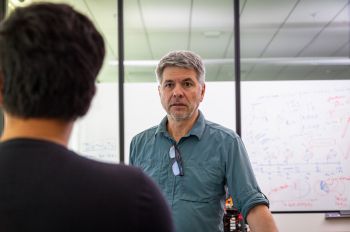$1.5 Million from DOE to Develop Battery for Electric Planes

Illinois Institute of Technology Assistant Professor of Chemical Engineering Mohammad Asadi’s novel lithium-air battery design has received $1.5 million in funding from the United States Department of Energy’s Advanced Research Projects Agency-Energy (ARPA-E) through the Pioneering Railroad, Oceanic, and Plane ELectrification with 1K energy storage systems (PROPEL-1K) program.
“One thousand watt-hours per kilogram is the key number needed to fully decarbonize aviation, shipping, and heavy duty trucking sectors,” says Asadi.
Anything less than 1,000 watt-hours would create major challenges in sizing and cost, but this is greater than three to four times the energy density provided by current battery technology. So ARPA-E has selected 13 research groups that have already been working in the high energy density battery space for the PROPEL-1K program, aiming to hit that milestone.
The program is in phase one, where all groups have been funded to demonstrate the strength of their technology at the lab scale. After one year, the groups that have made the most progress and reached the highest energy densities will move on to phase two, where the groups will receive additional funding to develop battery packs that will get tested in an actual heavy-duty transportation application.
For Asadi, this means continuing the work described in a 2023 Science paper, where he demonstrated the potential of one-of-a-kind solid-state lithium-air battery technology that uses a novel composite polymer solid-state electrolyte and a highly active catalyst for achieving this goal.
“Our technology, solid state lithium-air batteries, are one of the really promising options to take us to more than 1,000 watt-hours per kilogram of energy density by enabling a 4-electron transfer reaction,” he says. “We already have the infrastructure resources and team in place to make that happen.”
In addition to providing high energy density at the size required for use in transportation, utilizing technology that eliminates the liquid component of the battery improves safety and overall the battery materials are cheap and readily available.
Developing solid cell electrolyte technology is also expected to have broader impacts on battery technology, beyond heavy-duty applications.
“We’re developing a very thin layer of solid cell electrolyte, and if we achieve that then that technology can also be used in the existing technology for lithium-ion and lithium-metal batteries in electric vehicles to significantly increase their energy density, optimizing size, weight, and cost,” he says.
This effort supports United States President Joe Biden’s 2050 net-zero climate goals.
“Reducing emissions in the transportation sector—which is the largest contributor to the country’s greenhouse gas emissions—is critical to achieving President Biden’s clean energy and climate goals,” said ARPA-E director Evelyn N. Wang.
Most of the work will be done at Illinois Tech, but Asadi will also partner with Argonne National Laboratory for certain experiments and analysis and with Raytheon Technology to ensure that design choices align with requirements for aviation applications and are suitable for scaling up the technology.


![[From left to right] Associate Professor of Biomedical Engineering Kenneth Tichauer and Professor of Electrical and Computer Engineering Jovan Brankov](/sites/default/files/styles/width_350/public/2024-11/tichauer-brankov_1280x850.jpg?itok=hxdjBhlU)

